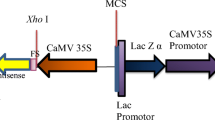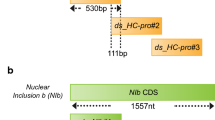Abstract
Posttranscriptional gene silencing, also known as RNA interference, involves degradation of homologous mRNA sequences in organisms. In plants, posttranscriptional gene silencing is part of a defense mechanism against virus infection, and double-stranded RNA is the pivotal factor that induces gene silencing. In this paper, we got seven hairpin RNAs (hpRNAs) constructs against different hot-spot sequences of Tobacco mosaic virus (TMV) or Potato virus Y (PVY) genome. After expression in Escherichia coli HT115, we extracted the seven hpRNAs for the test in tobacco against TMV or PVY infection. The data suggest that different hpRNAs against different hot-spot sequences of TMV or PVY genome had different ability to protect tobacco plants from viral infection. The resistance to TMV conferred by the hpRNA against the TMV movement protein was stronger than other TMV hpRNAs; the resistance to PVY conferred by the hpRNA against the PVY nuclear inclusion b was better than that induced by any other PVY hpRNAs. Northern blotting of siRNA showed that the resistance was indeed an RNA-mediated virus resistance.





Similar content being viewed by others
References
Lucas, G. B. (1975). Diseases of tobacco (3rd ed.). Raleigh: Biological Consulting Associates.
Shukla, D. D., Ward, C. W., & Brunt, A. A. (1994). The Potyviridae. Wallingford: CAB International.
Zhu, S. C., Wang, Y. T., & Wang, Z. F. (2002). Disease of tobacco in China, Beijing. Beijing: China Agriculture Press.
Al-Kaff, N. S., Covey, S. N., Kreike, M. M., Page, A. M., Pinder, R., & Dale, P. J. (1998). Science, 279, 2113–2115.
Baulcombe, D. C. (2000). Science, 290, 1108–1109.
Duan, C. G., Wang, C. H., Fang, R. X., & Guo, H. S. (2008). Journal of Virology, 82, 11084–11095.
Fitchen, J. H., & Beachy, R. N. (1993). Annual Review of Microbiology, 47, 739–763.
Hamilton, A. J., & Baulcombe, D. C. (1999). Science, 286, 950–952.
Llave, C., Kasschau, K. D., & Carrington, J. C. (2000). Proceedings of the National Academy of Sciences of the United States of America, 97, 13401–13406.
Vogler, H., Akbergenov, R., Shivaprasad, P. V., Dang, V., Fasler, M., Kwon, M. O., et al. (2007). Journal of Virology, 81, 10379–10388.
Zhu, C. X., Song, Y. Z., Yin, G. H., & Wen, F. J. (2008). Journal of Phytopathology, 157, 101–107.
Timmons, L., Court, D. L., & Fire, A. (2001). Gene, 263, 103–112.
Tenllado, F., Martínez-García, B., Vargas, M., & Díaz-Ruíz, J. R. (2003). BMC Biotechnology, 3, 3.
Goelet, P., Lomonossoff, G. P., Butler, P. J. G., Akam, M. E., Gait, M. J., & Karn, J. (1982). Proceedings of the National Academy of Sciences of the United States of America, 79, 5818–5822.
Dougherty, W. G., & Carrington, J. C. (1988). Annual Review of Phytopathology, 26, 123–143.
Dawson, W. O. (1999). Philos Trans R Soc Lond B Bio Sci, 354, 645–651.
Tribodet, M., Glais, L., Kerlan, C. J., & Acquot, E. (2005). The Journal of General Virology, 86, 2101–2105.
Sambrook, J., & Russell, D. W. (2001). Molecular cloning: a laboratory manual. NY: Cold Spring Harbor Laboratory Press.
Dasgupta, S., Fernandez, L., Kameyama, L., & Inada, T. (1998). Molecular Microbiology, 28, 629–640.
Takiff, H. E., Chen, S. M., & Court, D. L. (1989). Journal of Bacteriology, 171, 2581–2590.
Chen, P. Y., Wang, C. K., Soong, S. C., & To, K. Y. (2003). Molecular Breeding, 11, 287–293.
Liu, H. M., Zhu, C. X., Zhu, X. P., Guo, X. Q., Song, Y. Z., & Wen, F. J. (2007). Journal of Phytopathology, 155, 676–682.
Pall, G. S., Codony-Servat, C., Byrne, J., Ritchie, L., & Hamilton, A. J. (2007). Nucleic Acids Research, 35, e60.
Goto, K., Kanazawa, A., Kusaba, M., & Masuta, C. (2003). Plant Mol Biol Rep, 21, 51–58.
Smith, N. A., Singh, S. P., Wang, M. B., Stoutjesdijk, P. A., Green, A. G., & Waterhouse, P. M. (2000). Nature, 407, 319–320.
Vargas, M., Martínez-García, B., Díaz-Ruíz, J. R., & Tenllado, F. (2008). Virology Journal, 5, 42.
Waterhouse, P. M., Graham, M. W., & Wang, M. B. (1998). Proceedings of the National Academy of Sciences of the United States of America, 95, 13959–13964.
Zhu, C. X., Liu, H. M., Song, Y. Z., & Wen, F. J. (2005). Acta Genetica Sinica, 32, 94–103.
Zhu, J. H., Zhu, C. X., Wen, F. J., & Song, Y. Z. (2004). Acta Phytopathologica Sinica, 34, 133–140.
Yin, G. H., Sun, Z. N., Liu, N., Zhang, L., Song, Y. Z., Zhu, C. X., et al. (2009). Applied Microbiology and Biotechnology. doi:10.1007/s00253-009-1967-y.
Zhang, D. Y., Zhu, C. H., Cheng, F. X., He, M. Y., Zhang, Z. H., & Liu, Y. (2008). Acta Phytopathologica Sinica, 38, 304–311.
Zhao, N. S., Yun, Z. S., Guo, H. Y., Chang, X. Z., & Fu, J. W. (2009). Journal of Phytopathology. doi:10.1111/j.1439-0434.2009.01650.x.
Lawson, C., Kaniewski, W., Haley, L., Rozman, R., Newell, C., Sanders, P., et al. (1990). Biotechnology (N Y), 8, 127–134.
Wesley, S. V., Helliwell, C. A., Smith, N. A., Wang, M. B., Rouse, D. T., Liu, Q., et al. (2001). The Plant Journal, 27, 581–590.
Carr, J. P., Marsh, L. E., Lomonossoff, G. P., Sekiya, M. E., & Zaitlin, M. (1992). Mol Plant-Microbe Interact, 5, 397–404.
Donson, J., Kearney, C. M., Turpen, T. H., Khan, I. A., Kurath, G., Turpen, A. M., et al. (1993). Mol Plant-Microbe Interact, 6, 635–642.
Lomonossoff, G. P. (1995). Ann Rev Phytopathol, 33, 323–343.
Suzuki, M., Masuta, C., Takanami, Y., & Kuwata, S. (1993). FEBS Letters, 379, 26–30.
Cooper, B., Lapidot, M., Heick, J. A., Dodds, J. A., & Beachy, R. N. (1995). Virology, 206, 307–313.
Kotlizky, G., Katz, A., van der Laak, J., Boyko, V., Lapidot, M., Beachy, R. N., et al. (2001). Mol Plant-Microbe Interact, 14, 895–904.
Lapidot, M., Gafny, R., Ding, B., Wolf, S., Lucas, W. J., & Beachy, R. N. (1993). The Plant Journal, 4, 959–970.
Li, Y., Song, Y. Z., Zhu, C. X., & Wen, F. J. (2008). Acta Phytopathologica Sinica, 182, 145–155.
Hirai, S., Oka, S., & Adachi, E. (2007). Plant Cell Reports, 26(12), 651–659.
Acknowledgement
We acknowledge Li Wei for the kind gift of the bacterial strain HT115. This work was supported by the National Natural Science Foundation of China (No. 30771408) and the Excellent Youth and Middle Age Scientists Fund of Shan Dong Province (No. 2007BS06007).
Author information
Authors and Affiliations
Corresponding authors
Additional information
Zhao-Nan Sun and Guo-Hua Yin contributed equally to this paper.
An erratum to this article can be found at http://dx.doi.org/10.1007/s12010-010-8999-8
Rights and permissions
About this article
Cite this article
Sun, ZN., Yin, GH., Song, YZ. et al. Bacterially Expressed Double-Stranded RNAs against Hot-Spot Sequences of Tobacco Mosaic Virus or Potato Virus Y Genome Have Different Ability to Protect Tobacco from Viral Infection. Appl Biochem Biotechnol 162, 1901–1914 (2010). https://doi.org/10.1007/s12010-010-8968-2
Received:
Accepted:
Published:
Issue Date:
DOI: https://doi.org/10.1007/s12010-010-8968-2




